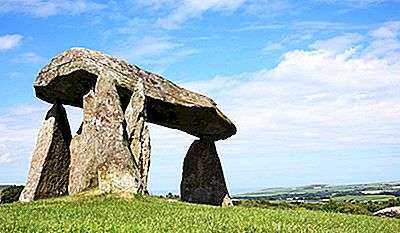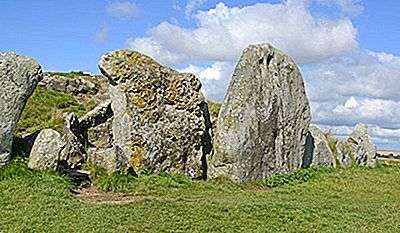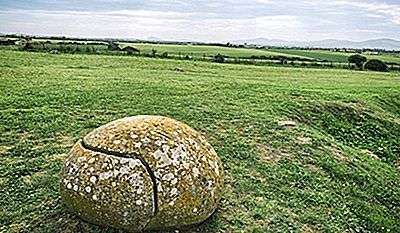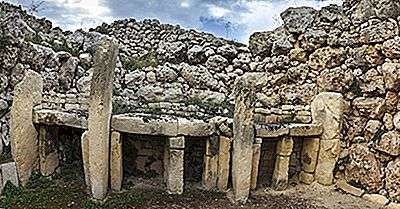The oldest buildings in the world have highlighted the beginnings of civilization. They also help us to understand the intellect of humans in a bygone era and its evolution.
10. Sechin Bajo, Peru – 3500 BCE
Sechin Bajo is a 30-hectare archaeological site, located at 370, north of Lima, Peru, in the Casma Valley. Sechin Bajo has buildings from the time when it was occupied. It is believed to have been the capital of pre-Inca culture in 1800 and 1900 BC. Recent archaeological excavations have revealed a circular stone square around 3500 BC. Sechin Bajo is considered the oldest complex in the New World and is part of a larger archaeological site called the Sechin complex.
9. Pentre Ifan, Wales – 3500 BCE

Pentre Ifan, Wales.
The funeral chamber of Pentre Ifan is a megalithic (stony) funeral chamber located in Pembrokeshire, Wales. Built around 3500 BC, it translates to Ivan’s Village and is the most popular megalithic site in the country. The burial chamber of Pentre Ifan came into being after excavations in the region revealed a cascade of 16 ton and 5 of balanced length on three huge stones 2.4 meters from the ground. The capstone points towards the river and the Nevern valley.
8. Listoghil, Ireland – 3550 BCE
Listoghil is a historic central tomb among other graves at Carrowmore in County Sligo, Ireland. The Carrowmore Tombs are one of the country’s four main funeral cemeteries. Listoghil is believed to have been established in 3550 BC. The tomb is one of a kind, the only one to have covered a cairn several meters high, before being looted for the construction of walls. Before being vandalized, the cairn had a diameter of 15. The tomb of Listoghil also presents megalithic engravings on the front and on the internal face of one of the stone pillars. Efforts to reconstruct the tomb in 32 have been controversial over how to restore and capture their historic authenticity.
7. West Kennet Long Barrow, England – 3650 BCE

West Kennet Long Barrow, England.
West Kennet Long Barrow is a group of chamber tombs dating from 3650 BC, an era known as the New Stone Age. These graves are located in Wiltshire, England, and many people were cremated and buried here before the graves were closed in 2000 BC, after having been used for at least 1000 years, according to the English Heritage Organization. The main passage was closed with earth, stones, rubble and debris and the forecourt with sarsen sandstone rocks. Excavations in 1859 and 1955 to 1956, unearthed pottery, stone tools like daggers and pearls dating from between 3000 and 2600 BC.
6. Ggantija, Malta – 3700 BCE
The antgantija temples are listed as World Heritage by UNESCO in Xaghra on the island of Gozo, in Malta. According to Heritage Malta, these two temples date from the period between 3600 and 3200 BC. The antgantija temples are among the oldest independent monuments in the world and precede Stonehenge and the Egyptian pyramids. The temples, located on a 3.155 property, are distinguished by their enormous Bronze Age structures. The space between the interior rooms and the exterior walls of the temples is filled with stones and earth that connect the structure. Temple builders also used local stones to build the temples. Hard coral limestone was used for exterior walls and soft Maltese limestone for interiors such as altars, doors and decorative slabs.
5. Knap of Howar, Scotland – 3700 BCE
The Knap of Howar is a Neolithic (New Stone Age) site located on Papa Westray Island in Orkney, Scotland. The building preserved on the site is considered to be the oldest stone house in northern Europe and dates from 3700 and 3500 BC. The Knap of Howar has two houses called farmhouses, built by a dry stone construction with an adjacent passage between them. The houses have two closets and stalls and have been occupied for 500 years, according to the Papay Development Trust. The farm stone walls are 1.6 meters high according to ancient history. Archaeological excavations in 1930 and 1970 have suggested that these structures were built on an older site and formed the core of an agricultural establishment at that time. Both houses are preserved by the sand blown by the wind.
4. Monte d’Accoddi, Italy – 4000 BCE

Monte d’Accoddi, Italy.
Monte d’Accoddi is an archaeological site discovered in 1954 and located in Sassari; northern Sardinia, Italy, and is nicknamed the step pyramid of Italy. The oldest sections of this site date from 4000 to 3650 BC, and historians have presumed that it was an altar or a temple, for lack of entrances or rooms. Monte d’Accoddi has a base of 27meters by 27 meters and a height of 5.5 meters. It has a platform of 12.5 meters per 7.2 meters accessible by a ramp. This site is the most complete representation of the prehistory of Sardinia, because it contains the most vital elements of innovation and tradition of the passage from the neolithic the Eneolithic period (transition between the neolithic age and the
3. Tumulus Saint-Michel, France – 4500 BCE
Tumulus Saint-Michel is a mound of stony stone located east of Carnac in north-west France. This mound dates back to 4500 BC and measures 12 in height, 125 in meters and 60 in meters, making it the largest burial mound in continental Europe. At the top of Tumulus Saint-Michel is a chapel offering a vintage view of the magnificent landscape, the bay of Quiberon and the Rhuys peninsula. The chapel is dedicated to Archangel Michael. When archaeologists searched it, they found prestigious objects made from Italian jadeite, which proves that the mound is the burial place of a person of high social rank, according to the National Center for French Monuments.
2. Tumulus de Bougon, France – 4700 BCE
Tumulus of Bougon is a series of five mounds dating from 4700, in the Bougon region, in the west of France. These archaeologists discovered these necropolises of the new Stone Age era, which are the oldest burial mounds in Europe. Mounds like the Bougon Tumulus were made from heavy slabs, some of which weigh up to 1840 tonnes. The Tumulus of Bougon gives an overview of the history of humanity in the Neolithic and the emergence of agrarian communities, new technologies such as stone polishing, weaving, pottery and human settlements, according to Memo Travel . This is because in the Neolithic era, the dead were buried with offerings, and the excavations proved the aforementioned lifestyle.
1. Barnenez, France – 4850 BCE
Located in Brittany, France, the Cairn of Barnenez is one of the oldest structures on the planet and dates back to 4850 BC. This cairn measures 72, 20 to 25 and 9, and has 11 burial chambers with passages. According to the National Center of French Monuments, it is a representation of the Neolithic where the use of polished stone, animal husbandry and agriculture began. The Barnenez cairn is located on top of a hill along the coast of the English Channel. It is remarkable for its long appearance and the sawtooth patterns of the stones that compose it. The stones have V-shaped engravings and dotted axes. Barnenez’s Cairn is expected to weigh between 12,000 and 14,000 metric tonnes. The entrances to the burial chambers face south-east towards the sunrise.

